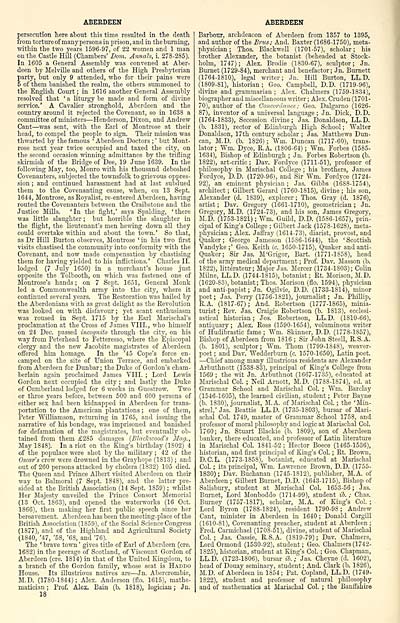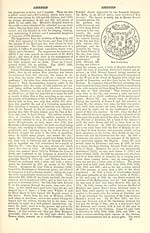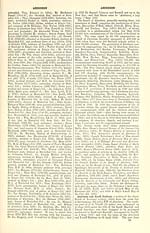Ordnance gazetteer of Scotland > Volume 1
(46) Page 18
Download files
Complete book:
Individual page:
Thumbnail gallery: Grid view | List view

ABERDEEN
persecution here about this time resulted in the death
from torture of many persons in prison , and in the burning,
within the two years 1596-97, of 22 women and 1 man
on the Castle Hill (Chambers' Bom. Annals, i. 278-285).
In 1605 a General Assembly was convened at Aber-
deen by Melville and others of the High Presbyterian
party, but only 9 attended, who for their pains were
5 of them banished the realm, the others summoned to
the English Court ; in 1616 another General Assembly
resolved that ' a liturgy be made and form of divine
service.' A Cavalier stronghold, Aberdeen and the
country around it rejected the Covenant, so in 1638 a
committee of ministers — Henderson, Dixon, and Andrew
Cant — was sent, with the Earl of Montrose at their
head, to compel the people to sign. Their mission was
thwarted by the famous ' Aberdeen Doctors ; ' but Mont-
rose nest year twice occupied and taxed the city, on
the second occasion winning admittance by the trilling
skirmish of the Bridge of Dee, 19 June 1639. In the
following May, too, Monro with his thousand deboshed
Covenanters, subjected the townsfolk to grievous oppres-
sion ; and continued harassment had at last subdued
them to the Covenanting cause, when, on 13 Sept.
1644, Montrose, as Royalist, re-entered Aberdeen, having
routed the Covenanters between the Craibstone and the
Justice Mills. 'In the fight,' says Spalding, 'there
was little slaughter ; but horrible the slaughter in
the flight, the lieutenant's men hewing down all they
could overtake within and about the town. ' So that,
as Dr Hill Burton observes, Montrose ' in his two first
visits chastised the community into conformity with the
Covenant, and now made compensation by chastising
them for having yielded to his inflictions.' Charles II.
lodged (7 July 1650) in a merchant's house just
opposite the Tolbooth, on which was fastened one of
Montrose's hands ; on 7 Sept. 1651, General Monk
led a Commonwealth army into the city, where it
continued several years. The Restoration was hailed by
the Aberdonians with as great delight as the Revolution
was looked on with disfavour ; yet scant enthusiasm
was roused in Sept. 1715 by the Earl Marischal's
proclamation at the Cross of James VIII., who himself
on 24 Dec. passed incognito through the city, on his
way from Peterhead to Fetteresso, where the Episcopal
clergy and the new Jacobite magistrates of Aberdeen
offered him homage. In the '45 Cope's force en-
camped on the site of Union Terrace, and embarked
from Aberdeen for Dunbar; the Duke of Gordon's cham-
berlain again proclaimed James VIII. ; Lord Lewis
Gordon next occupied the city ; and lastly the Duke
of Cumberland lodged for 6 weeks in Guestrow. Two
or three years before, between 500 and 600 persons of
either sex had been kidnapped in Aberdeen for trans-
portation to the American plantations ; one of them,
Peter Williamson, returning in 1765, and issuing the
narrative of his bondage, was imprisoned and banished
for defamation of the magistrates, but eventually ob-
tained from them £285 damages (Blackwood's Mag.,
May 1848). In a riot on the King's birthday (1S02) 4
of the populace were shot by the military ; 42 of the
Oscar's crew were drowned in the Grayhope (1813) ; and
out of 260 persons attacked by cholera (1S32) 105 died.
The Queen and Prince Albert visited Aberdeen on their
way to Balmoral (7 Sept. 1848), and the latter pre-
sided at the British Association (14 Sept. 1S59) ; whilst
Her Majesty unveiled the Prince Consort Memorial
(13 Oct. 1863), and opened the waterworks (16 Oct.
1S66), then making her first public speech since her
bereavement. Aberdeen has been the meeting-place of the
British Association (1859), of the Social Science Congress
(1877), and of the Highland and Agricultural Society
(1840, '47, '58, '6S, and 76).
The ' brave town ' gives title of Earl of Aberdeen (ere.
1682) in the peerage of Scotland, of Viscount Gordon of
Aberdeen (ere. 1814) in that of the United Kingdom, to
a branch of the Gordon family, whose seat is Haddo
House. Its illustrious natives are — Jn. Abercrombie,
M.D. (1780-1844) ; Alex. Anderson (flo. 1615), mathe-
matician ; Prof. Alex. Bain (b. 1818), logician ; Jn.
18
ABERDEEN
Barbour, archdeacon of Aberdeen from 1357 to 1395,
and author of the Brus; And. Baxter (1686-1750), meta-
physician ; Thos. Blackwell (1701-57), scholar ; his
brother Alexander, the botanist (beheaded at Stock-
holm, 1747); Alex. Brodie (1830-67), sculptor; Jn.
Burnet (1729-84), merchant and benefactor; Jn. Burnett
(1764-1810), legal writer; Jn. Hill Burton, LL.D.
(1809-81), historian; Geo. Campbell, D.D. (1719-96),
divine and grammarian ; Alex. Chalmers (1759-1834),
biographer and miscellaneous writer ; Alex. Cruden (1701-
70), author of the Concordance ; Geo. Dalgarno (1626-
87), inventor of a universal language; Jn. Dick, D.D.
(1764-1833), Secession divine ; Jas. Donaldson, LL.D.
(b. 1831), rector of Edinburgh High School; Walter
Donaldson, 17th century scholar ; Jas. Matthews Dun-
can, M.D. (b. 1826); Wm. Duncan (1717-60), trans-
lator; Wm. Dyce, R.A. (1806-64); Wm. Forbes (1585-
1634), Bishop of Edinburgh ; Jn. Forbes Robertson (b.
1822), art-critic ; Dav. Fordyce (1711-51), professor of
philosophy in Marischal College ; his brothers, James
Fordyce, D.D. (1720-96), and Sir Wm. Fordyce (1724-
92), an eminent physician ; Jas. Gibbs (1688-1754),
architect ; Gilbert Gerard (1760-1815), divine ; his son,
Alexander (d. 1839), explorer; Thos. Gray (d. 1876),
artist ; Dav. Gregory (1661-1710), geometrician ; Jn.
Gregory, M.D. (1724-73), and his son, James Gregory,
M.D. (1753-1821) ; Wm. Guild, D.D. (1586-1657), prin-
cipal of King's College ; Gilbert Jack (1578-1628), meta-
physician ; Alex. Jaifray (1614-73), diarist, provost, and
Quaker; George Jameson (1586-1644), the 'Scottish
Vandyke;' Geo. Keith (c. 1650-1715), Quaker and anti-
Quaker; Sir Jas. M'Grigor, Bart. (1771-1S58), head
of the army medical department ; Prof. Dav. Masson (b.
1822), litterateur; Major Jas. Mercer (1734-1803); Colin
Milne, LL.D. (1744-1815), botanist; Rt. Morison, M.D.
(1620-83), botanist ; Thos. Morison (flo. 1594), physician
and anti -papist ; Jn. Ogilvie, D.D. (1733-1814), minor
poet; Jas. Perry (1756-1821), journalist ; Jn. Phillip,
R.A. (1817-67) ; And. Robertson (1777-1865), minia-
turist ; Rev. Jas. Craigie Robertson (b. 1813), ecclesi-
astical historian; Jos. Robertson, LL.D. (1810-66),
antiquary; Alex. Ross (1590-1654), voluminous writer
of Hudibrastic fame; Wm. Skinner, D.D. (1778-1857),
Bishop of Aberdeen from 1816 ; Sir John Steell, R.S.A.
(b. 1801), sculptor; Wm. Thorn (1799-1848), weaver-
poet ; and Dav. Wedderburn (c. 1570-1650), Latin poet.
— Chief among many illustrious residents are Alexander
Arbuthnott (1538-83), principal of King's College from
1569 ; the wit Jn. Arbuthnot (1667-1735), educated at
Marischal Col. ; Neil Arnott, M.D. (178S-1S74), ed. at
Grammar School and Marischal Col. ; Wm. Barclay
(1546-1605), the learned civilian, student ; Peter Bayne
(b. 1830), journalist, M.A. of Marischal Col. ; the 'Min-
strel,' Jas. Beattie LL.D. (1735-1803), bursar of Mari-
schal Col. 1749, master of Grammar School 1758, and
professor of moral philosophy and logic at Marischal Col.
1760; Jn. Stuart Blackie (b. 1809), son of Aberdeen
banker, there educated, and professor of Latin literature
in Marischal Col. 1841-52 ; Hector Boece (1465-1536),
historian, and first principal of King's Col. ; Rt. Brown,
D.C.L. (1773-1858), botanist, educated at Marischal
Col. ; its principal, Wm. Lawrence Brown, D.D. (1755-
1830) ; Dav. Buchanan (1745-1812), publisher, M.A. of
Aberdeen ; Gilbert Burnet, D.D. (1643-1715), Bishop of
Salisbury, student at Marischal Col. 1653-56 ; Jas.
Burnet, Lord Monboddo (1714-99), student ib. ; Chas.
Burney (1757-1817), scholar, M.A. of King's Col. ;
Lord Byron (1788-1824), resident 1790-98 ; Andrew
Cant, minister in Aberdeen in 1640 ; Donald Cargill
(1610-81), Covenanting preacher, student at Aberdeen ;
Fred. Carmichael (1708-51), divine, student of Marischal
Col.; Jas. Cassie, R.S.A. (1819-79); Dav. Chalmers,
Lord Ormond (1530-92), student ; Geo. Chalmers (1742-
1S25), historian, student at King's Col. ; Geo. Chapman,
LL.D. (1723-1S06), bursar*. ; Jas. Cheyne (d. 1602),
head of Douay seminary, student; And. Clark (b. 1S26),
M.D. of Aberdeen in 1854; Pat. Copland, LL.D. (1749-
1822), student and professor of natural philosophy
and of mathematics at Marischal Col. ; the Banffshire
persecution here about this time resulted in the death
from torture of many persons in prison , and in the burning,
within the two years 1596-97, of 22 women and 1 man
on the Castle Hill (Chambers' Bom. Annals, i. 278-285).
In 1605 a General Assembly was convened at Aber-
deen by Melville and others of the High Presbyterian
party, but only 9 attended, who for their pains were
5 of them banished the realm, the others summoned to
the English Court ; in 1616 another General Assembly
resolved that ' a liturgy be made and form of divine
service.' A Cavalier stronghold, Aberdeen and the
country around it rejected the Covenant, so in 1638 a
committee of ministers — Henderson, Dixon, and Andrew
Cant — was sent, with the Earl of Montrose at their
head, to compel the people to sign. Their mission was
thwarted by the famous ' Aberdeen Doctors ; ' but Mont-
rose nest year twice occupied and taxed the city, on
the second occasion winning admittance by the trilling
skirmish of the Bridge of Dee, 19 June 1639. In the
following May, too, Monro with his thousand deboshed
Covenanters, subjected the townsfolk to grievous oppres-
sion ; and continued harassment had at last subdued
them to the Covenanting cause, when, on 13 Sept.
1644, Montrose, as Royalist, re-entered Aberdeen, having
routed the Covenanters between the Craibstone and the
Justice Mills. 'In the fight,' says Spalding, 'there
was little slaughter ; but horrible the slaughter in
the flight, the lieutenant's men hewing down all they
could overtake within and about the town. ' So that,
as Dr Hill Burton observes, Montrose ' in his two first
visits chastised the community into conformity with the
Covenant, and now made compensation by chastising
them for having yielded to his inflictions.' Charles II.
lodged (7 July 1650) in a merchant's house just
opposite the Tolbooth, on which was fastened one of
Montrose's hands ; on 7 Sept. 1651, General Monk
led a Commonwealth army into the city, where it
continued several years. The Restoration was hailed by
the Aberdonians with as great delight as the Revolution
was looked on with disfavour ; yet scant enthusiasm
was roused in Sept. 1715 by the Earl Marischal's
proclamation at the Cross of James VIII., who himself
on 24 Dec. passed incognito through the city, on his
way from Peterhead to Fetteresso, where the Episcopal
clergy and the new Jacobite magistrates of Aberdeen
offered him homage. In the '45 Cope's force en-
camped on the site of Union Terrace, and embarked
from Aberdeen for Dunbar; the Duke of Gordon's cham-
berlain again proclaimed James VIII. ; Lord Lewis
Gordon next occupied the city ; and lastly the Duke
of Cumberland lodged for 6 weeks in Guestrow. Two
or three years before, between 500 and 600 persons of
either sex had been kidnapped in Aberdeen for trans-
portation to the American plantations ; one of them,
Peter Williamson, returning in 1765, and issuing the
narrative of his bondage, was imprisoned and banished
for defamation of the magistrates, but eventually ob-
tained from them £285 damages (Blackwood's Mag.,
May 1848). In a riot on the King's birthday (1S02) 4
of the populace were shot by the military ; 42 of the
Oscar's crew were drowned in the Grayhope (1813) ; and
out of 260 persons attacked by cholera (1S32) 105 died.
The Queen and Prince Albert visited Aberdeen on their
way to Balmoral (7 Sept. 1848), and the latter pre-
sided at the British Association (14 Sept. 1S59) ; whilst
Her Majesty unveiled the Prince Consort Memorial
(13 Oct. 1863), and opened the waterworks (16 Oct.
1S66), then making her first public speech since her
bereavement. Aberdeen has been the meeting-place of the
British Association (1859), of the Social Science Congress
(1877), and of the Highland and Agricultural Society
(1840, '47, '58, '6S, and 76).
The ' brave town ' gives title of Earl of Aberdeen (ere.
1682) in the peerage of Scotland, of Viscount Gordon of
Aberdeen (ere. 1814) in that of the United Kingdom, to
a branch of the Gordon family, whose seat is Haddo
House. Its illustrious natives are — Jn. Abercrombie,
M.D. (1780-1844) ; Alex. Anderson (flo. 1615), mathe-
matician ; Prof. Alex. Bain (b. 1818), logician ; Jn.
18
ABERDEEN
Barbour, archdeacon of Aberdeen from 1357 to 1395,
and author of the Brus; And. Baxter (1686-1750), meta-
physician ; Thos. Blackwell (1701-57), scholar ; his
brother Alexander, the botanist (beheaded at Stock-
holm, 1747); Alex. Brodie (1830-67), sculptor; Jn.
Burnet (1729-84), merchant and benefactor; Jn. Burnett
(1764-1810), legal writer; Jn. Hill Burton, LL.D.
(1809-81), historian; Geo. Campbell, D.D. (1719-96),
divine and grammarian ; Alex. Chalmers (1759-1834),
biographer and miscellaneous writer ; Alex. Cruden (1701-
70), author of the Concordance ; Geo. Dalgarno (1626-
87), inventor of a universal language; Jn. Dick, D.D.
(1764-1833), Secession divine ; Jas. Donaldson, LL.D.
(b. 1831), rector of Edinburgh High School; Walter
Donaldson, 17th century scholar ; Jas. Matthews Dun-
can, M.D. (b. 1826); Wm. Duncan (1717-60), trans-
lator; Wm. Dyce, R.A. (1806-64); Wm. Forbes (1585-
1634), Bishop of Edinburgh ; Jn. Forbes Robertson (b.
1822), art-critic ; Dav. Fordyce (1711-51), professor of
philosophy in Marischal College ; his brothers, James
Fordyce, D.D. (1720-96), and Sir Wm. Fordyce (1724-
92), an eminent physician ; Jas. Gibbs (1688-1754),
architect ; Gilbert Gerard (1760-1815), divine ; his son,
Alexander (d. 1839), explorer; Thos. Gray (d. 1876),
artist ; Dav. Gregory (1661-1710), geometrician ; Jn.
Gregory, M.D. (1724-73), and his son, James Gregory,
M.D. (1753-1821) ; Wm. Guild, D.D. (1586-1657), prin-
cipal of King's College ; Gilbert Jack (1578-1628), meta-
physician ; Alex. Jaifray (1614-73), diarist, provost, and
Quaker; George Jameson (1586-1644), the 'Scottish
Vandyke;' Geo. Keith (c. 1650-1715), Quaker and anti-
Quaker; Sir Jas. M'Grigor, Bart. (1771-1S58), head
of the army medical department ; Prof. Dav. Masson (b.
1822), litterateur; Major Jas. Mercer (1734-1803); Colin
Milne, LL.D. (1744-1815), botanist; Rt. Morison, M.D.
(1620-83), botanist ; Thos. Morison (flo. 1594), physician
and anti -papist ; Jn. Ogilvie, D.D. (1733-1814), minor
poet; Jas. Perry (1756-1821), journalist ; Jn. Phillip,
R.A. (1817-67) ; And. Robertson (1777-1865), minia-
turist ; Rev. Jas. Craigie Robertson (b. 1813), ecclesi-
astical historian; Jos. Robertson, LL.D. (1810-66),
antiquary; Alex. Ross (1590-1654), voluminous writer
of Hudibrastic fame; Wm. Skinner, D.D. (1778-1857),
Bishop of Aberdeen from 1816 ; Sir John Steell, R.S.A.
(b. 1801), sculptor; Wm. Thorn (1799-1848), weaver-
poet ; and Dav. Wedderburn (c. 1570-1650), Latin poet.
— Chief among many illustrious residents are Alexander
Arbuthnott (1538-83), principal of King's College from
1569 ; the wit Jn. Arbuthnot (1667-1735), educated at
Marischal Col. ; Neil Arnott, M.D. (178S-1S74), ed. at
Grammar School and Marischal Col. ; Wm. Barclay
(1546-1605), the learned civilian, student ; Peter Bayne
(b. 1830), journalist, M.A. of Marischal Col. ; the 'Min-
strel,' Jas. Beattie LL.D. (1735-1803), bursar of Mari-
schal Col. 1749, master of Grammar School 1758, and
professor of moral philosophy and logic at Marischal Col.
1760; Jn. Stuart Blackie (b. 1809), son of Aberdeen
banker, there educated, and professor of Latin literature
in Marischal Col. 1841-52 ; Hector Boece (1465-1536),
historian, and first principal of King's Col. ; Rt. Brown,
D.C.L. (1773-1858), botanist, educated at Marischal
Col. ; its principal, Wm. Lawrence Brown, D.D. (1755-
1830) ; Dav. Buchanan (1745-1812), publisher, M.A. of
Aberdeen ; Gilbert Burnet, D.D. (1643-1715), Bishop of
Salisbury, student at Marischal Col. 1653-56 ; Jas.
Burnet, Lord Monboddo (1714-99), student ib. ; Chas.
Burney (1757-1817), scholar, M.A. of King's Col. ;
Lord Byron (1788-1824), resident 1790-98 ; Andrew
Cant, minister in Aberdeen in 1640 ; Donald Cargill
(1610-81), Covenanting preacher, student at Aberdeen ;
Fred. Carmichael (1708-51), divine, student of Marischal
Col.; Jas. Cassie, R.S.A. (1819-79); Dav. Chalmers,
Lord Ormond (1530-92), student ; Geo. Chalmers (1742-
1S25), historian, student at King's Col. ; Geo. Chapman,
LL.D. (1723-1S06), bursar*. ; Jas. Cheyne (d. 1602),
head of Douay seminary, student; And. Clark (b. 1S26),
M.D. of Aberdeen in 1854; Pat. Copland, LL.D. (1749-
1822), student and professor of natural philosophy
and of mathematics at Marischal Col. ; the Banffshire
Set display mode to: Large image | Transcription
Images and transcriptions on this page, including medium image downloads, may be used under the Creative Commons Attribution 4.0 International Licence unless otherwise stated. ![]()
| Gazetteers of Scotland, 1803-1901 > Ordnance gazetteer of Scotland > Volume 1 > (46) Page 18 |
|---|
| Permanent URL | https://digital.nls.uk/97369318 |
|---|
| Attribution and copyright: |
|
|---|---|

